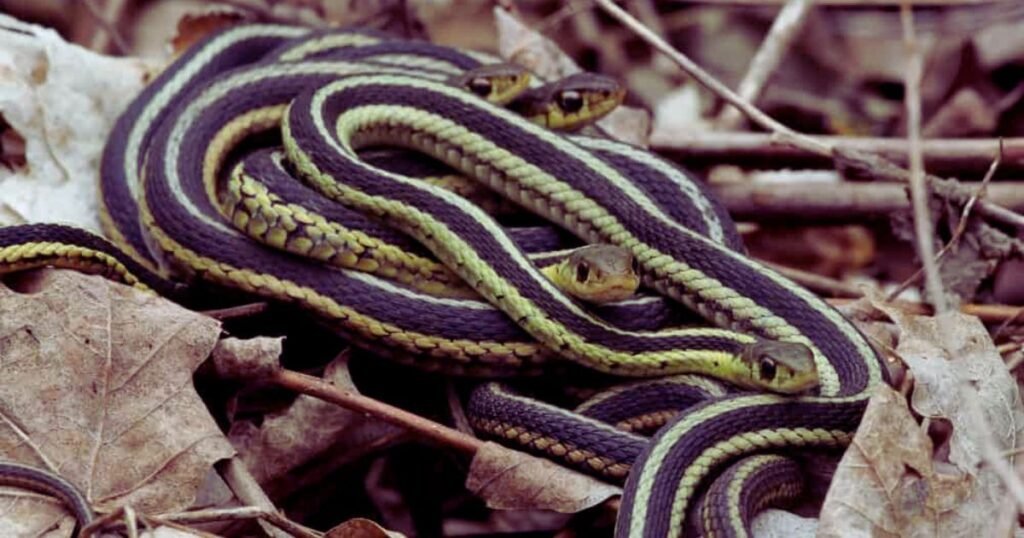Wisconsin, the Badger State, is home to a variety of snakes that play a vital role in the state’s ecosystem. With its diverse landscape, Snakes in Wisconsin ranging from forests to prairies and wetlands, Wisconsin provides habitat for over 20 species of snakes. In this article, we’ll explore the different types of snakes found in Wisconsin, their habits, habitats, and behavior, as well as some interesting facts about these slithering creatures.
Read More: White Lipped Python

1. Introduction to Snakes in Wisconsin
Wisconsin’s snake population is diverse, ranging from harmless garden snakes to venomous rattlesnakes. Most of the snakes found in the state are non-venomous and pose no threat to humans. However, it’s essential to be aware of the few venomous snakes found in the region and learn how to identify them to avoid any potential danger.
2. Common Snakes in Wisconsin
Some of the most common snakes found in Wisconsin include garter snakes, milk snakes, eastern hognose snakes, and smooth green snakes. Garter snakes are the most prevalent snake species in the state, with several subspecies found in different regions. These snakes are harmless and often found in gardens and fields, where they feed on insects, worms, and small rodents.
3. Venomous Snakes in Wisconsin
Wisconsin is home to two venomous snake species: the timber rattlesnake and the massasauga rattlesnake. These snakes are rare and only found in certain areas of the state. Both species are shy and will usually avoid human contact. However, it’s important to be aware of their habitats and learn how to identify them to avoid any potential danger.
4. Habitat and Behavior of Snakes in Wisconsin
Snakes in Wisconsin occupy a variety of habitats, including forests, wetlands, grasslands, and rocky areas. Some species, like the smooth green snake, prefer wooded areas, while others, like the western hognose snake, inhabit prairies and grasslands. Snakes are cold-blooded animals, meaning their body temperature fluctuates with the environment. During the winter months, snakes in Wisconsin hibernate in underground dens to avoid the cold temperatures.

5. Snake Conservation Efforts in Wisconsin
Several conservation efforts are in place to protect Wisconsin’s snake populations. The Wisconsin Department of Natural Resources monitors snake habitats and conducts surveys to identify areas where snakes are thriving. Habitat preservation and restoration projects are also underway to create suitable environments for snakes to thrive.
6. Interesting Facts about Snakes in Wisconsin
Did you know that Wisconsin’s state wildlife animal is the timber rattlesnake? Or that snakes can unhinge their jaws to swallow prey much larger than their heads? Snakes are fascinating creatures with unique characteristics, and Wisconsin’s snake population is no exception.
7. Snake Safety Tips
While most snakes in Wisconsin are harmless, it’s important to take precautions to avoid any potential danger. Avoid disturbing snake habitats, wear protective clothing when in areas where venomous snakes are found, and learn how to identify venomous snake species. If you encounter a snake, maintain a safe distance and do not attempt to touch or handle it.
8. Conclusion
Wisconsin’s snake population is diverse and plays an essential role in the state’s ecosystem. While some species are venomous, most are harmless and provide benefits by controlling pest populations. By taking precautions and learning about the different snake species found in Wisconsin, we can coexist with these fascinating creatures and protect their habitats.
Read More: Snakes in Wisconsin

9. FAQs
Are all snakes in Wisconsin venomous?
No, only two species of snakes in Wisconsin are venomous – the timber rattlesnake and the massasauga rattlesnake.
How can I identify a venomous snake in Wisconsin?
Venomous snakes in Wisconsin have a triangular head, vertical pupils, and a rattle on their tail.
What should I do if I encounter a snake in the wild?
If you encounter a snake in the wild, keep a safe distance and do not approach it. If the snake is venomous, seek medical attention immediately if bitten.
Can snakes in Wisconsin swim?
Yes, many snakes in Wisconsin are excellent swimmers and can be found near bodies of water.
What is the best way to prevent snakes from entering my home?
To prevent snakes from entering your home, ensure that all openings are sealed, and keep your yard free of clutter and debris.










